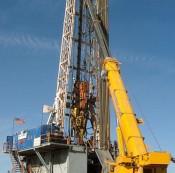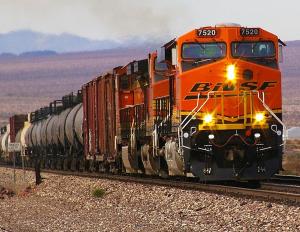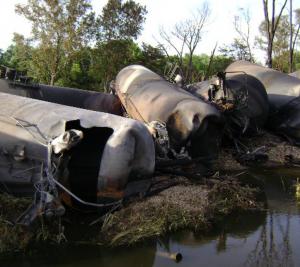
Triggering a giant fireball, the mile-long train carrying Bakken crude oil that crashed recently near Casselton, ND, not only spilled 400,000 gallons of crude, it showed how surging oil production in North Dakota - which barely trails Texas - has raced ahead of traditional infrastructure such as pipelines and even puncture-resistant railcars.
Last year across the US, record oil production rose 992,000 barrels a day to a daily total of 7.5 million, the International Energy Agency (IEA) estimates, and production was still surging through November and December, to possibly over eight million. As a result, US production climbed to its highest level since 1989.
The oil surge has surprised everyone
America's energy boom has left so much oil sloshing around the country that it's even surprised experts. "We keep raising our forecasts, and we keep underestimating production," Lejla Alic, a Paris-based analyst with the IEA, told the New York Times. The increase in 2013 topped 2012's increase of 836,000 barrels a day.
Predictably, this rapidly growing oil production has run up against a severe pipeline

shortage in North Dakota's Bakken oil field, where about two-thirds of the crude oil is now shipped by rail.
Although pipeline companies are scrambling to connect these new fields, and moving crude by pipeline still costs less, railroads solved the transportation bottleneck more quickly. By laying just a few miles of track and building new loading facilities, oil and gas drillers have quickly connected remote areas in North Dakota with national railroads like the Union Pacific and BNSF Railway, which both carry about 400,000 barrels out of the region each day. According to a June report by Bloomberg:
...71 percent of all Bakken crude now leaves the region by train, compared with 25 percent in January 2012. Only 20 percent travels by pipeline, down from 61 percent in 2011.
A stopgap has now become a fixture in the nation's energy landscape, with 200 "virtual pipelines" snaking across the horizon daily.
Increasing oil spills
But by moving so much oil by rail, spills have increased. There have been 10 large spills in the US and Canada over the last 10 months. Records show that spills in the US last year far outpaced the total amount spilled by railroads from 1975 to 2012. The New York Times supplied some numbers:
...From 1975 to 2012, federal records show, railroads spilled 800,000 gallons of crude oil. Last year alone, they spilled more than 1.15 million gallons, according to the Pipeline and Hazardous Materials Safety Administration....
How quickly has this problem grown? In 2010, railroads spilled about 5,000 gallons of crude oil, according to federal data. Going back even further in time, spills were nonexistent. In eight of the years between 1975 and 2009, railroads reported no crude oil spills.
But the difference is obvious: until very recently, railroads weren't carrying oil in long 80- to 100-car trains. "This has developed overnight, and they've been playing catch-up with the infrastructure," Deborah A. P. Hersman, the chairwoman of the National Transportation Safety Board, told the New York Times.
Even though the spill numbers are huge, there's still a strong overall safety record. Railroads shipped 400,000 carloads of crude oil last year; with each tank car holding about 28,800 gallons, it adds up to more than 11.5 billion gallons, according to MSN News, so:
Last year's total spills of 1.15 million gallons means that 99.99 percent of shipments arrived without incident...
Explosions highlight another safety problem
But it's the most recent explosions that have highlighted another serious problem. Federal officials declared that the Bakken's light, sweet crude oil is prone to ignite at a lower temperature. Experts say lighter crudes contain more natural gas and have a much lower flash point.
While far more toxic products are shipped on trains, those products, such as chlorine, are transported in pressurized vessels designed to survive an accident. Crude oil, on the other hand, is shipped in a DOT-111 tank car that entered service in 1964 and that has been traditionally used for nonflammable hazardous liquids like liquid fertilizers.
After a 2009 ethanol train crash and fire in Illinois, the National Transportation Safety

Board said that the old versions of the DOT-111 container car should be retrofitted or phased out because they are likely to be punctured in the case of a derailment. New DOT-111 tank cars have thicker walls, among other requirements.
When the BNSF Railway train exploded in North Dakota on Dec. 30, the safety board said, 18 of 20 older, oil-carrying DOT-111 cars that derailed were punctured.
Unfortunately, there are about 92,000 DOT-111 tank cars currently used to move crude oil and ethanol across the US, and about 78,000 cars should be retrofitted to be made safer or phased out. Fortunately, tank cars built since Oct. 1, 2011, are required to comply with tougher standards, including shells with thicker steel, but there are only about 14,000 of these.
According to Fuel Fix, railways, oil companies, refiners, and even tank car producers support new regulations that could force tank car owners to make upgrades, but:
The upgrades could cost $2,000 to $80,000 per car, depending on the amount of work required, said Thomas Simpson, president of the Railway Supply Institute, which represents car owners and manufacturers.
The American Association of Railroads has said the total upgrade cost could exceed $1 billion, estimating an average cost of $15,000 to retrofit each tank car. And Railway associations say upgrading, repurposing or retiring the old model cars could take seven to 10 years.


